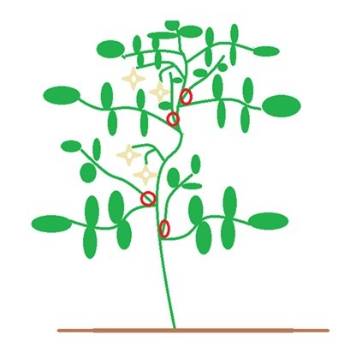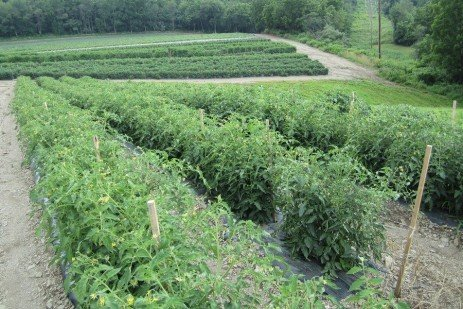Tomato Support and Pruning
How is your garden growing? By the end of May many of us have most of our gardens planted, except for some of our winter squash and sweet potatoes. Tomatoes are probably the most popular vegetable that people grow in their gardens every year. While tomatoes are pretty easy to grow there are a few things that we need to think of now so our tomatoes can be productive this year. Pruning your tomatoes and providing adequate support for the plants as they grow can make a big difference in how productive, disease free and easy to harvest your plants can be. Before the plants get too big it’s time to do some preventative work so the summer can be stress free.

Until a couple years ago I hadn’t really given a thought to pruning tomatoes. I would periodically trim the vines back so they didn’t get too out of control but beyond that I just let them grow wild. Turns out pruning your tomatoes can help them be more productive and disease free in the long run. Pruning can help balance the ratio of vegetative growth to fruiting growth which can help produce larger fruit and it also allows more air flow through the plants so they are less likely to have disease issues. The first pruning should happen when the tomatoes are planted and that is to remove the bottom leaves that are touching the ground. The second pruning should happen when the plants are approximately 18-24” tall and applies to all types of tomatoes (except the micro sized ones). This time you will remove all the leaves 6-12” above the soil and you will also remove all the suckers up to the first bloom cluster. Removing these leaves helps to reduce the chances of having soil borne diseases on tomatoes and removing the suckers helps keep the tomatoes in check. If you have a determinate variety of tomato your pruning is done for the year. Indeterminate varieties will require a bit more work as you will continue to remove the suckers (like the picture to the right) as the plant grows throughout the season. You can also prune the ends of the tomato vines on indeterminate tomatoes to keep them somewhat in check. Check out this video from Iowa State on pruning tomatoes and some more tips on how to prune.
Once you have your tomatoes planted and you have removed the bottom leaves the second thing to consider is how are you supporting the tomato plant. I won’t spend much time talking about tomato cages because most people know about them but they aren’t the only option. For those of us who dislike storing tomato cages there are alternatives. One of the most popular with commercial growers is to use trellises to support the plants. There are two major methods, the first is to use a string trellis suspended from wire that is strung between two posts. You twist the string around the stem of the plant as it grows to support it. With this method you do prune off any side shoots every week or so and leave just the main stem. This system works really well for indeterminate type tomatoes. To learn more about this method of trellising tomatoes check out this video by the University of Maine. The second method of trellis is called the Florida Basket weave. This method is similar to the string trellis except instead of the strings being overhead the strings run parallel to the ground and the tomatoes are woven between the strands as they grow. This method also works well for determinate and indeterminate types of tomatoes. To learn more about how to grow tomatoes using the Florida Basket weave watch this video by K-State Research and Extension. The final option for growing tomatoes is to use a stake for every plant and tie the tomato to it as it grows up. This method works similar to the string trellis method talked about earlier but without the string.


